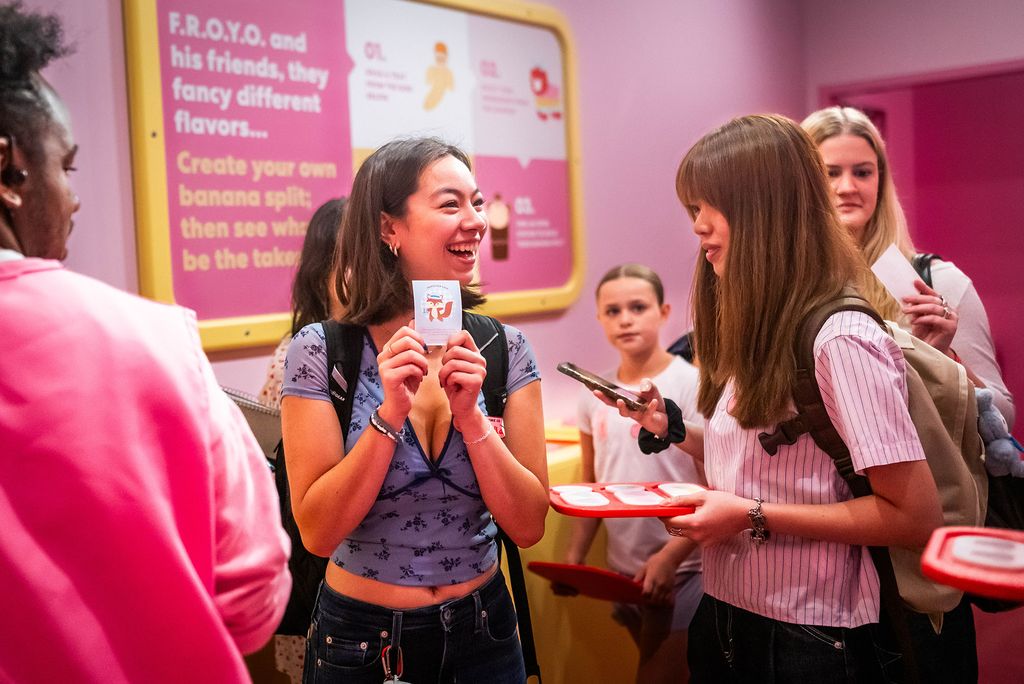SHA Students Partner with Museum of Ice Cream for Hands-on Learning Experience
Helping address ways to improve customer experience

Students in Introduction to Customer Experience Management, an SHA Summer Session Two course, on a July 9 field trip to the Boston Museum of Ice Cream.
SHA Students Partner with Museum of Ice Cream for Hands-on Learning Experience
Helping address ways to improve customer experience
Boston University’s summer courses cover a wide variety of topics: art, mathematics, history, and…ice cream?
For one School of Hospitality Administration class, that was exactly the assignment.
This summer, students enrolled in Introduction to Customer Experience Management partnered with the Museum of Ice Cream (MOIC) in Boston’s Seaport.
The SHA course introduces students to what it takes to create high-quality customer experiences. The course draws on aspects of marketing, behavioral science, data science, and operational management. Students work on a larger team project, plus individual projects designed to help an industry improve its operations.
Why the Museum of Ice Cream?
“As part of this course, students have to take any sector of the economy and apply the principles of hospitality and customer experience management to improve the customer experience in that sector,” says Makarand Mody, an SHA associate professor of hospitality marketing and the Summer Session Two course instructor. When he reached out to the recently opened museum’s staff about partnering on an experiential learning project, they were happy for the help.
“Instead of working on a theoretical project, students applied the concepts and tools we learn in the course and solved two customer experience management problems—one for each team—that MOIC is facing, thus taking their learning beyond the classroom to the city of Boston,” Mody says.

Boston’s MOIC is one of several across the country, in addition to a location in Singapore. The Seaport branch opened its doors in December 2024. The museum features multiple themed rooms where guests get to learn about ice cream, play around with interactive features—and, of course, eat a whole lot of samples.
Ice cream already engenders joy, says MOIC general manager Jacob Leithner. Creating a pleasant and exciting experience for guests is the cherry on top of the museum’s hospitality sundae.
“When Dr. Mody reached out to me, I jumped at the chance to be involved with the next generation of [industry] leaders,” says Leithner, a longtime hospitality professional. “Getting an outside eye on the guest experience, and a meaningful presentation meant to help us grow and improve, is invaluable.”
Real-world applications
“In here, we don’t have real names or real problems,” Leithner—known inside the museum by his “ice cream name,” Almond—told the eight students in the class when they visited in early July.
The students were there to get a sense of how the building operates and what might need room for improvement. After going through the museum, they sat down for a Q&A session with Leithner and an assistant manager.
As the students learned, recent museum improvements include introducing timed entry to avoid long queues at check-in. Measures that are currently underway involve making sure each room has enough facilitators to guide guests through interactions, as well as figuring out where to store large items like strollers.
Mody says It’s fun to see his students switch lenses from consumer to purveyor.

“I think the Museum of Ice Cream is largely representative of where our experiences seem to be moving,” he says, citing a crop of new museums and interactive exhibitions centered on subjects like Formula One and pickleball in recent years. “These are things that students might go to with their friends, and not think twice about what goes into making them enjoyable. So I think it’s really interesting for them to step back and think about an experience from a designer’s perspective, not a customer’s.”
As for what the students ended up recommending?
One team settled on the issues of dead space and guest interactivity.
When visiting the museum, the students noticed “a lot of space between exhibits, and the staff didn’t all interact well with the guests,” says Levy Lempert (SHA’26). His team proposed giving staff better scripts to use, putting activities between the rooms, and adding “fun, nostalgic pieces designed to spark joy in parents visiting with their kids,” he says.
The other team had similar suggestions.
“We focused on turning dull wait times at the MOIC into joyful and immersive experiences for customers,” says Batr Qattan (CAS’25).
Some of the team’s fixes included adding an interactive screen for customers to engage with while waiting to enter a particular room, having fewer customers per room, and assigning staff members to guide flow throughout the attractions.
The project taught Qattan that creating memorable experiences doesn’t always require million-dollar solutions. “Sometimes it’s the little details [that make all the difference],” he says. Working with a real-world client also made the class “10 times more fun,” he says. “It felt like our work had a real impact.”
Which, according to Leithner, it did: “We thoroughly enjoyed the presentations from the two teams,” he says, “and have been able to find several ways to incorporate their ideas for better guest flow and experience.
“I was very impressed with the level of detail and thought that went into the presentations and hope to continue partnering with SHA in the future.”
Comments & Discussion
Boston University moderates comments to facilitate an informed, substantive, civil conversation. Abusive, profane, self-promotional, misleading, incoherent or off-topic comments will be rejected. Moderators are staffed during regular business hours (EST) and can only accept comments written in English. Statistics or facts must include a citation or a link to the citation.